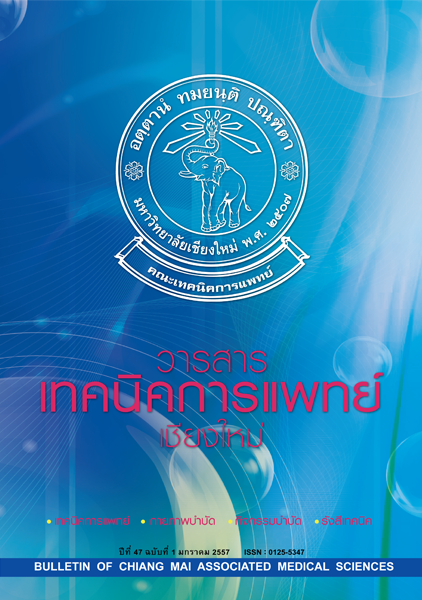The assessment of exposure index on the posterior-anterior computed radiography chest in Srinagarind Hospital, Khon Kaen University
Main Article Content
Abstract
Introduction: A screen-film system has been replaced by computed radiography (CR) system in Thailand. The advantages of CR are that it provides faster process and better contrast resolution. The major role of CR system is that it allows user to define an imaging technique which does not only provide good image quality, but also reduce the patient radiation dose as the ALARA principle. Radiation exposure index is a numerical value recommended by a manufacturer (manufacturer recommended range; MRR). As for the international requirements, this value is used to remind a radiologic technician to determine an appropriate radiation exposure for the imaging. An excessive radiation exposure can cause an unnecessary radiation dose. Conversely, insufficient radiation exposure can cause a noise on the image which reduces the image quality. This might cause an adversely effect on the diagnosis.
Objectives: The purpose of this study was to investigate whether the exposure indicators of posterior–anterior computed radiography chest are in the MRR ranges and also whether higher or not.
Materials and methods: The retrospective study was performed in 1005 patients at Srinagarind Hospital, aged above 16 years old from June 2012 to March 2013. The S values measured from Fuji FCR 5000 on the PA radiographic chest were recorded.
Results: The results showed that only 69 percent of all the images were in the range specified by the
manufacturer (S value 200-600). Fifteen percent of the measures were greater than the MRR ranges
(S value >600) which is defined as underexposure. Sixteen percent of the S-values were less than the MRR range (S value <600) which is defined as overexposure. It was considered that the radiation exposure tends to increase.
Conclusions: The results of the study demonstrated that an accuracy of the exposure index calibration is required as the number can correctly represent the amount of radiation used to create the image and the quality of image. In order to reduce the radiation dose on patients and obtain a high image quality, the radiation exposure charts are required to determine an appropriate radiation exposure for different organs.
Bull Chiang Mai Assoc Med Sci 2014; 47(1): 23-29
Article Details
Personal views expressed by the contributors in their articles are not necessarily those of the Journal of Associated Medical Sciences, Faculty of Associated Medical Sciences, Chiang Mai University.


